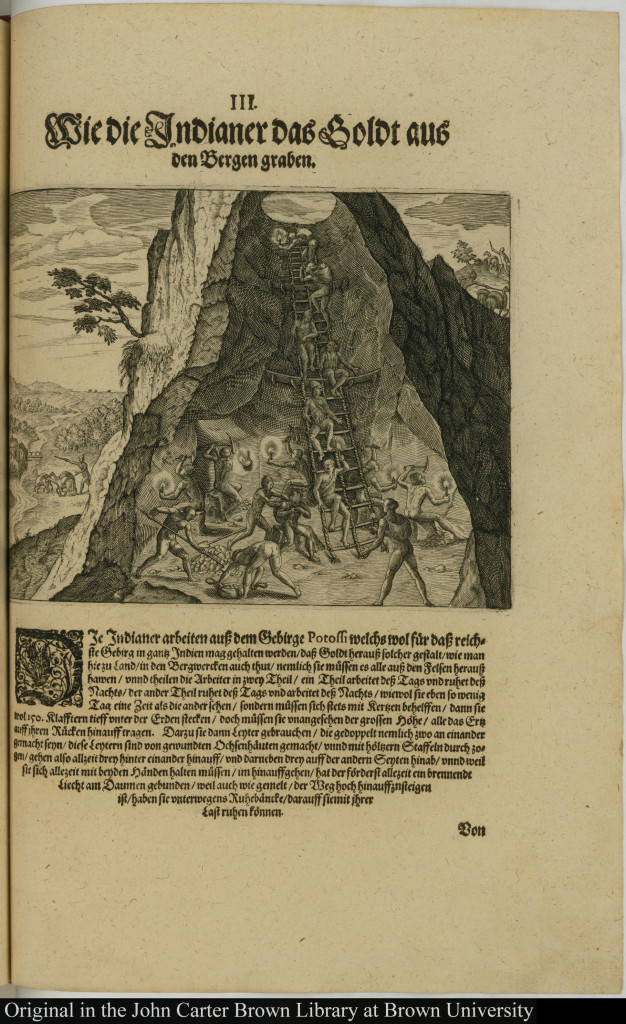Northern European rivals obsessed with Spanish mineral treasure embraced the tradition of publicising the coveted place they had never seen and would never possess. The renowned Flemish engraver, publisher and Black Legend propagandist Theodor de Bry never visited Potosí, or America for that matter, but he gleefully rendered its underground world visible for his avid readers. Based on his reading of the work of the Spanish Jesuit scholar José de Acosta, who had personally visited Potosí in the 1580s, de Bry created what may be the most reproduced image of the Cerro Rico after Cieza de León’s foundational Cerro Rico de Potosi. Viewers of this 1601 image in De Bry’s History of America may take it as a generic, stylised picture of mining operations but it is clear from the details that de Bry followed Acosta’s description. The workers climbing up and down the fixed rawhide ladder are just as Acosta describes them. The ore sack ‘backpacks’, the candles held in one hand by some workers, even the llamas barely visible above right and below left, where there is also a ore-crushing mill, all follow Acosta’s words.
Bry’s Potosi
Theodor de Bry, Historiae Americae VI (1601; courtesy of John Carter Brown Library at Brown University).
Kris Lane
Further reading
- Arzáns de Orsúa y Vela, B. (1965) Historia de la Villa Imperial de Potosí, 3 vols., edited by L. Hanke and G. Mendoza (Providence, RI: Brown University Press).
- Bakewell, P.J. (1985) Miners of the Red Mountain: Indian Labor in Potosí, 1545–1650 (Albuquerque, NM: University of New Mexico Press).
- Bakewell, P.J. (1987) Silver and Entrepreneurship in Seventeenth-Century Potosí: The Life and Times of Antonio López de Quiroga (Albuquerque, NM: University of New Mexico Press).
- Barragán Romano, R. (2019) Potosí global: viajando con sus primeras imágenes (1550–1650) (La Paz: Plural Editores).
- Bueuchler, R.M. (1981) The Mining Society of Potosí, 1776–1810 (Syracuse, NY: Syracuse University Press).
- Capoche, L. (1959) Relación general de la Villa Imperial de Potosí [1585]. BAE 122. Edited Hanke (Madrid: Atlas).
- Cole, J. (1985) The Potosí Mita, 1573–1700: Compulsory Indian Labor in the Andes (Stanford, CA: Stanford University Press).
- González Casasnovas, I. (2000) Las dudas de la corona: la política de repartimientos para la minería de Potosí (1680–1732) (Madrid: CSIC).
- Lane, K. (2019) Potosí: The Silver City That Changed the World (Oakland, CA: University of California Press).
- Mangan, J. (2005) Trading Roles: Gender, Ethnicity, and the Urban Economy in Colonial Potosí (Durham, NC: Duke University Press).
- Tandeter, E. (1993) Coercion and Market: Silver Mining in Colonial Potosí, 1692–1826 (Albuquerque, NM: University of New Mexico Press).





